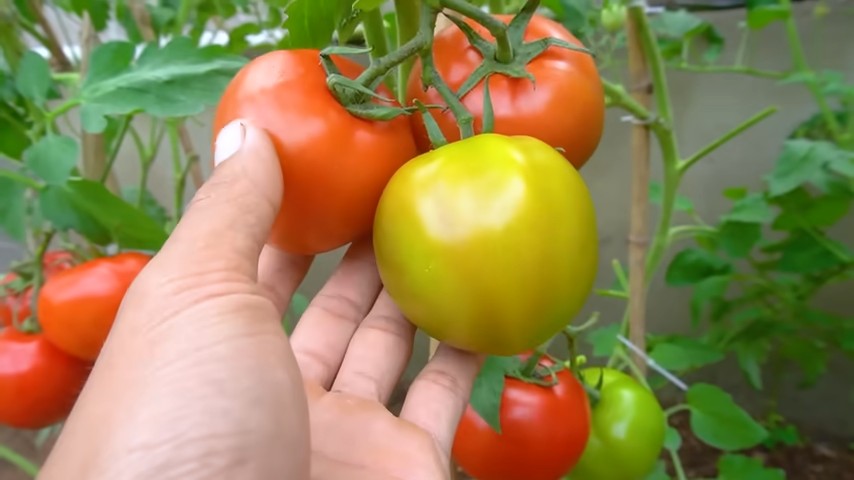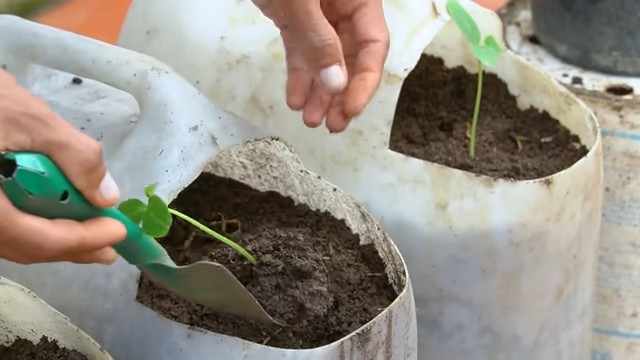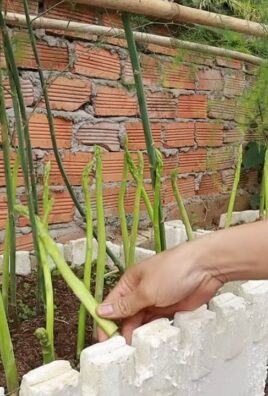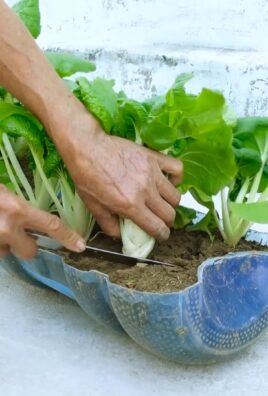Beginner Tomato Planter No Yard? No problem! I’m so excited to share some incredible DIY tricks that will have you harvesting juicy, delicious tomatoes even if you don’t have a traditional garden.
For centuries, growing your own food has been a source of sustenance and pride. From ancient Roman rooftop gardens to the “Victory Gardens” of World War II, people have always found ways to cultivate edible plants, regardless of space constraints. The desire to connect with nature and enjoy fresh, homegrown produce is deeply ingrained in us.
But let’s face it, not everyone has access to a sprawling backyard. Apartment living, small patios, or even just a lack of time can make traditional gardening seem impossible. That’s where these DIY hacks come in! I’m going to show you how to become a successful beginner tomato planter no yard required. These simple, budget-friendly solutions will empower you to grow your own tomatoes in containers, on balconies, or even indoors.
Imagine biting into a sun-ripened tomato you grew yourself – the taste is simply unmatched! Plus, you’ll know exactly what went into growing it, avoiding harmful pesticides and supporting sustainable practices. So, if you’ve always dreamed of growing your own tomatoes but thought you didn’t have the space, get ready to be amazed. Let’s dive into these easy and effective beginner tomato planter no yard solutions and transform your living space into a thriving tomato haven!

DIY Tomato Planter for Small Spaces: Grow Delicious Tomatoes Anywhere!
Hey there, fellow tomato lovers! Do you dream of sinking your teeth into a juicy, homegrown tomato but lack the space for a traditional garden? Don’t worry, I’ve got you covered! This guide will walk you through creating a fantastic tomato planter perfect for balconies, patios, or even sunny windowsills. We’re going to build a self-watering container that maximizes space and minimizes the need for constant watering. Get ready to enjoy fresh, flavorful tomatoes, no matter how small your living space!
What You’ll Need
Before we dive in, let’s gather our supplies. This project is relatively inexpensive and uses readily available materials. Here’s what you’ll need:
* Two Plastic Storage Bins: One larger (approximately 20-30 gallons) and one slightly smaller (approximately 15-20 gallons) that can fit inside the larger one. Make sure they are food-grade plastic, especially the inner bin.
* Drill with Various Drill Bits: You’ll need a small bit for drainage holes and a larger bit (around 1-inch) for the overflow hole.
* PVC Pipe: A length of PVC pipe (around 2-3 inches in diameter and 12-18 inches long) for the watering tube.
* PVC End Cap: To close off the bottom of the PVC pipe.
* Landscape Fabric: To prevent soil from clogging the reservoir.
* Potting Mix: A high-quality potting mix specifically formulated for vegetables.
* Tomato Seedling: Choose a variety suitable for container gardening, like determinate or dwarf varieties.
* Watering Can or Hose: For watering your tomato plant.
* Measuring Tape or Ruler: For accurate measurements.
* Utility Knife or Scissors: For cutting the landscape fabric.
* Optional: Mulch (straw or wood chips) to help retain moisture.
* Optional: Tomato cage or stakes for support.
Building Your Self-Watering Tomato Planter
Okay, let’s get our hands dirty! This is where the fun begins. We’ll be transforming these plastic bins into a thriving tomato haven.
Preparing the Inner Container (The Planting Basket)
1. Drill Drainage Holes: Take the smaller plastic bin (the one that will sit inside the larger bin). Using a small drill bit (around 1/4 inch), drill several drainage holes in the bottom of the bin. Space them about 2-3 inches apart. These holes are crucial for allowing excess water to drain into the reservoir.
2. Cut Landscape Fabric: Cut a piece of landscape fabric that is slightly larger than the bottom of the inner bin. This will act as a filter, preventing soil from washing into the water reservoir.
3. Line the Bottom: Place the landscape fabric inside the inner bin, covering the drainage holes. Make sure it extends up the sides a bit. This will help prevent soil from clogging the holes.
Creating the Water Reservoir
1. Prepare the Outer Container: Take the larger plastic bin. This will be our water reservoir.
2. Position the Inner Container: Place the inner container (with the drainage holes and landscape fabric) inside the larger container. You’ll notice that the inner container sits on the bottom of the outer container. We need to create a space for water to collect.
3. Elevate the Inner Container: You can use bricks, rocks, or even empty plastic bottles to elevate the inner container. The goal is to create a gap of about 4-6 inches between the bottom of the inner container and the bottom of the outer container. This space will hold the water reservoir. Make sure the supports are stable and evenly distributed to prevent the inner container from tipping.
4. Drill Overflow Hole: With the inner container in place, determine the desired water level in the reservoir. Drill an overflow hole in the side of the outer container, just below the bottom of the inner container. This hole will prevent the reservoir from overfilling and potentially drowning your tomato plant. Use a larger drill bit (around 1 inch) for this hole.
Installing the Watering Tube
1. Prepare the PVC Pipe: Take the PVC pipe and the end cap. Attach the end cap to one end of the PVC pipe. This will prevent soil from entering the pipe from the bottom.
2. Position the Watering Tube: Place the PVC pipe vertically inside the inner container, near one of the corners. The capped end should be resting on the bottom of the outer container (the reservoir).
3. Secure the Watering Tube (Optional): You can use zip ties or duct tape to secure the PVC pipe to the side of the inner container. This will prevent it from tipping over when you add soil.
Planting Your Tomato Seedling
1. Fill with Potting Mix: Now, carefully fill the inner container with high-quality potting mix. Leave a few inches of space at the top.
2. Plant the Seedling: Dig a hole in the center of the potting mix large enough to accommodate the root ball of your tomato seedling. Gently remove the seedling from its container and place it in the hole.
3. Backfill with Potting Mix: Fill the hole around the seedling with potting mix, gently patting it down.
4. Water Thoroughly: Water the potting mix thoroughly, making sure the water reaches the bottom of the container and starts to fill the reservoir. You’ll see water draining out of the overflow hole when the reservoir is full.
Adding Support (Optional)
1. Install Tomato Cage or Stakes: As your tomato plant grows, it will need support to prevent the branches from breaking under the weight of the fruit. Install a tomato cage or stakes around the plant.
2. Tie Up Branches: As the plant grows taller, tie the branches to the cage or stakes using soft twine or plant ties.
Caring for Your Tomato Plant
Now that your tomato plant is happily settled in its new home, let’s talk about how to keep it thriving.
* Watering: The beauty of this self-watering system is that you don’t need to water as frequently. Simply fill the reservoir through the PVC pipe when the water level gets low. Check the moisture level of the soil occasionally to ensure it’s not too dry.
* Sunlight: Tomato plants need at least 6-8 hours of sunlight per day. Place your planter in a sunny location. If you don’t have enough natural sunlight, you can supplement with grow lights.
* Fertilizing: Feed your tomato plant regularly with a balanced fertilizer specifically formulated for tomatoes. Follow the instructions on the fertilizer package.
* Pruning: Prune your tomato plant regularly to remove suckers (the small shoots that grow between the main stem and the branches). This will help the plant focus its energy on producing fruit.
* Pest Control: Keep an eye out for pests like aphids, whiteflies, and tomato hornworms. Treat any infestations promptly with insecticidal soap or other appropriate methods.
* Mulching: Add a layer of mulch (straw or wood chips) to the top of the potting mix to help retain moisture and suppress weeds.
Troubleshooting
Even with the best intentions, sometimes things don’t go exactly as planned. Here are a few common issues you might encounter and how to fix them:
* Yellowing Leaves: This could be a sign of overwatering, underwatering, or nutrient deficiency. Check the moisture level of the soil and adjust your watering accordingly. Fertilize the plant if necessary.
* Blossom End Rot: This is a condition where the bottom of the tomato turns black and leathery. It’s usually caused by calcium deficiency. Add calcium to the soil or use a calcium-rich fertilizer.
* Pests: As mentioned earlier, keep an eye out for pests and treat them promptly.
* Slow Growth: This could be due to lack of sunlight, poor soil, or nutrient deficiency. Make sure the plant is getting enough sunlight and fertilize it regularly.
Choosing the Right Tomato Variety
Not all tomato varieties are created equal, especially when it comes to container gardening. Here are a few of my favorite varieties that thrive in containers:
* Determinate Varieties: These varieties grow to a specific size and produce all their fruit at once. They are a good choice for smaller containers. Examples include Roma, Celebrity, and Patio.
* Dwarf Varieties: These are even smaller than determinate varieties and are perfect for very small spaces. Examples include Tiny Tim and Micro Tom.
* Indeterminate Varieties: These varieties continue to grow and produce fruit throughout the growing season. They require more space and support than determinate varieties. If you choose an indeterminate variety, make sure you have a large enough container and a sturdy tomato cage. Examples include Cherry, Grape, and Beefsteak (though these may need a very large container).
Tips for Success
Here are a few extra tips to help

Conclusion
So, you’re ready to ditch the store-bought, flavorless tomatoes and embark on your own tomato-growing adventure, even without a traditional yard? This beginner-friendly, no-yard tomato planter trick is more than just a gardening hack; it’s a gateway to fresh, sun-ripened goodness right outside your door. It’s about reclaiming control over your food source, experiencing the satisfaction of nurturing life, and, most importantly, enjoying the unparalleled taste of homegrown tomatoes.
Why is this a must-try? Because it democratizes gardening. It removes the barriers of space, experience, and even a green thumb. You don’t need acres of land or years of horticultural expertise to succeed. This method is designed for simplicity and accessibility, making it perfect for apartment dwellers, balcony gardeners, or anyone simply looking for an easy and rewarding way to grow their own food.
Beyond the ease of setup and maintenance, this method offers incredible flexibility. Want to grow cherry tomatoes? Go for it! Prefer beefsteak tomatoes for slicing? No problem! Experiment with different varieties to discover your favorites. You can also customize your planter with companion plants like basil or marigolds to enhance flavor and deter pests. Consider adding a small trellis or support structure as your tomato plants grow taller, especially for larger varieties. You can even try different types of containers – from repurposed buckets to stylish planters – to match your aesthetic. The possibilities are endless!
This DIY tomato planter trick is a game-changer for urban gardeners. It’s a sustainable, cost-effective, and incredibly rewarding way to enjoy fresh tomatoes all season long. Imagine the vibrant salads, the flavorful sauces, and the juicy sandwiches you can create with your own homegrown bounty.
Don’t just take our word for it. We urge you to give this method a try. It’s easier than you think, and the rewards are immeasurable. Start small, learn as you go, and don’t be afraid to experiment. We’re confident that you’ll be amazed at what you can achieve, even without a traditional yard.
Once you’ve harvested your first juicy tomato, we want to hear about it! Share your experiences, tips, and photos with us in the comments below. Let’s build a community of no-yard tomato growers and inspire others to embrace the joy of homegrown goodness. What variety did you choose? What challenges did you face? What successes did you celebrate? Your insights can help others on their tomato-growing journey. So, grab your supplies, get your hands dirty, and get ready to taste the difference that homegrown tomatoes can make! Let’s grow together!
Frequently Asked Questions (FAQ)
What kind of container should I use for my no-yard tomato planter?
The best container for your no-yard tomato planter is one that’s large enough to accommodate the root system of a mature tomato plant. A minimum of 5-gallon capacity is recommended, but larger is generally better. Consider using a 10-gallon or even a 20-gallon container for larger tomato varieties like beefsteaks. The container should also have drainage holes to prevent waterlogging, which can lead to root rot. You can use plastic pots, terracotta pots, fabric grow bags, or even repurposed buckets, as long as they meet these requirements. Dark-colored containers can heat up quickly in direct sunlight, so consider using lighter colors or placing them in a slightly shaded area.
What type of soil is best for growing tomatoes in containers?
Avoid using garden soil in containers, as it tends to compact and doesn’t drain well. Instead, opt for a high-quality potting mix specifically formulated for containers. These mixes are typically lighter and more porous, providing better drainage and aeration for the roots. Look for a potting mix that contains ingredients like peat moss, perlite, vermiculite, and compost. You can also amend your potting mix with slow-release fertilizer to provide a steady supply of nutrients to your tomato plants.
How much sunlight do my tomato plants need?
Tomato plants need at least 6-8 hours of direct sunlight per day to thrive. Choose a location for your no-yard tomato planter that receives ample sunlight throughout the day. If you don’t have a spot that gets full sun, you can supplement with grow lights. Rotate your plants regularly to ensure that all sides receive equal exposure to sunlight.
How often should I water my tomato plants in containers?
Water your tomato plants deeply and regularly, especially during hot and dry weather. Check the soil moisture level by sticking your finger about an inch into the soil. If the soil feels dry, it’s time to water. Water at the base of the plant, avoiding wetting the foliage, which can increase the risk of fungal diseases. Container-grown tomatoes tend to dry out more quickly than those grown in the ground, so you may need to water them daily or even twice a day during peak summer months.
What kind of fertilizer should I use for my tomato plants?
Tomato plants are heavy feeders and require regular fertilization to produce abundant fruit. Use a balanced fertilizer with an NPK ratio (nitrogen, phosphorus, potassium) of around 10-10-10 or 14-14-14. You can also use a fertilizer specifically formulated for tomatoes, which will typically have a higher phosphorus content to promote fruit development. Fertilize your tomato plants every 2-3 weeks, following the instructions on the fertilizer package. You can also supplement with compost tea or other organic fertilizers.
How do I prevent pests and diseases from affecting my tomato plants?
Prevention is key when it comes to pests and diseases. Start by choosing disease-resistant tomato varieties. Inspect your plants regularly for signs of pests or diseases, such as aphids, whiteflies, or fungal spots. Remove any affected leaves or plants immediately. You can also use organic pest control methods, such as insecticidal soap or neem oil, to control pests. Ensure good air circulation around your plants to prevent fungal diseases. Avoid overwatering and water at the base of the plant to keep the foliage dry.
Do I need to prune my tomato plants?
Pruning can help improve air circulation, promote fruit production, and prevent diseases. Remove suckers (the small shoots that grow between the main stem and the branches) from indeterminate tomato varieties. Determinate varieties generally don’t require pruning. You can also remove any yellowing or diseased leaves.
How do I know when my tomatoes are ripe?
The color of the tomato will change from green to its mature color (red, yellow, orange, etc.). The tomato should also feel slightly soft to the touch. Gently twist the tomato from the vine; if it comes off easily, it’s ripe. The taste is the ultimate indicator of ripeness.
Can I grow tomatoes indoors using this method?
While this method is primarily designed for outdoor growing, you can grow tomatoes indoors if you have a sunny window or grow lights. You’ll need to provide adequate light, warmth, and ventilation. Choose smaller tomato varieties that are well-suited for container growing.
What if I don’t have a balcony or patio?
Even without a balcony or patio, you can still grow tomatoes using this method. Place your container near a sunny window or use grow lights. You can also grow tomatoes on a rooftop or in a community garden. The key is to find a location that receives ample sunlight and provides adequate space for your plants to grow.




Leave a Comment